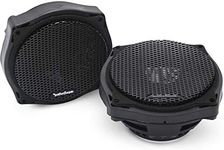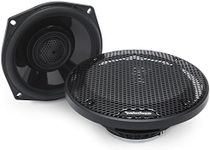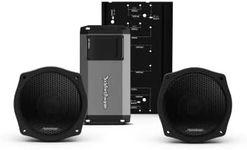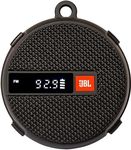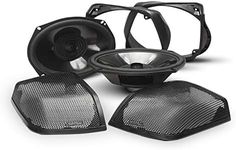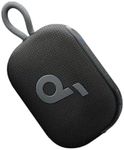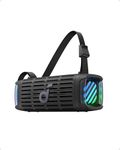Buying Guide for the Best Motorcycle Speakers
Choosing the right motorcycle speakers can make your rides much more enjoyable by letting you listen to music, podcasts, or navigation instructions clearly, even at high speeds. Since motorcycles are exposed to the elements and have unique noise challenges, it's important to focus on features that ensure durability, sound quality, and compatibility with your bike. Understanding the key specifications will help you find speakers that fit your needs and enhance your riding experience.Power Output (Wattage)Power output, measured in watts, tells you how loud and clear your speakers can get. Higher wattage generally means the speakers can produce louder sound without distortion, which is important on a motorcycle where wind and engine noise can be significant. Speakers typically range from around 15 watts to over 100 watts per speaker. Lower wattage speakers (under 30W) are suitable for casual listening at lower speeds or in quieter environments. Mid-range (30-60W) works well for most riders who want good volume and clarity at moderate speeds. High wattage (over 60W) is best for those who ride at high speeds or want the loudest, clearest sound possible. Consider your typical riding conditions and how much volume you need to enjoy your audio.
Speaker SizeSpeaker size, usually measured in inches, affects both the sound quality and where you can mount the speakers on your motorcycle. Common sizes are 3, 4, and 5.25 inches. Smaller speakers (3 inches) are easier to fit on most bikes and are less noticeable, but may not produce as much bass or volume. Medium sizes (4 inches) offer a good balance between sound quality and fit. Larger speakers (5.25 inches and above) can deliver richer sound and deeper bass, but require more space and may need custom mounting. Choose a size that fits your bike’s available space and your preference for sound quality.
Weather Resistance (IP Rating)Weather resistance is crucial for motorcycle speakers since they are exposed to rain, dust, and sun. The IP (Ingress Protection) rating tells you how well the speakers can handle these elements. An IPX4 rating means the speakers are splash-resistant, while IPX6 or higher means they can withstand heavy rain and even direct water jets. If you often ride in unpredictable weather or leave your bike outdoors, look for higher IP ratings to ensure your speakers last longer and keep working well.
Mounting OptionsMounting options refer to how and where the speakers can be attached to your motorcycle. Some speakers are designed for handlebars, while others can be mounted on fairings or crash bars. Handlebar mounts are the most common and easiest to install, but may limit the size of the speaker. Fairing mounts can accommodate larger speakers and may offer better sound direction. Consider your bike’s design and where you have space to mount speakers, as well as how easy you want the installation process to be.
Connectivity (Wired vs. Wireless/Bluetooth)Connectivity determines how you play music through your speakers. Wired speakers connect directly to your motorcycle’s audio system or a music player, offering reliable sound but requiring more installation effort. Wireless or Bluetooth speakers let you connect your phone or other devices without cables, making them more convenient and flexible. However, they may need to be recharged or have batteries replaced. If you want the simplest setup and often use your phone for music, Bluetooth is a good choice. If you prefer a permanent, always-ready system, wired speakers might be better.
Amplifier RequirementSome motorcycle speakers need an external amplifier to reach their full potential, while others have built-in amplifiers. An amplifier boosts the audio signal, making the sound louder and clearer. If you want high volume and the best sound quality, especially at highway speeds, you may need an external amp. Built-in amps are easier to install and are fine for casual listening. Think about how much effort you want to put into installation and how loud you want your music to be when deciding if you need an amplifier.
